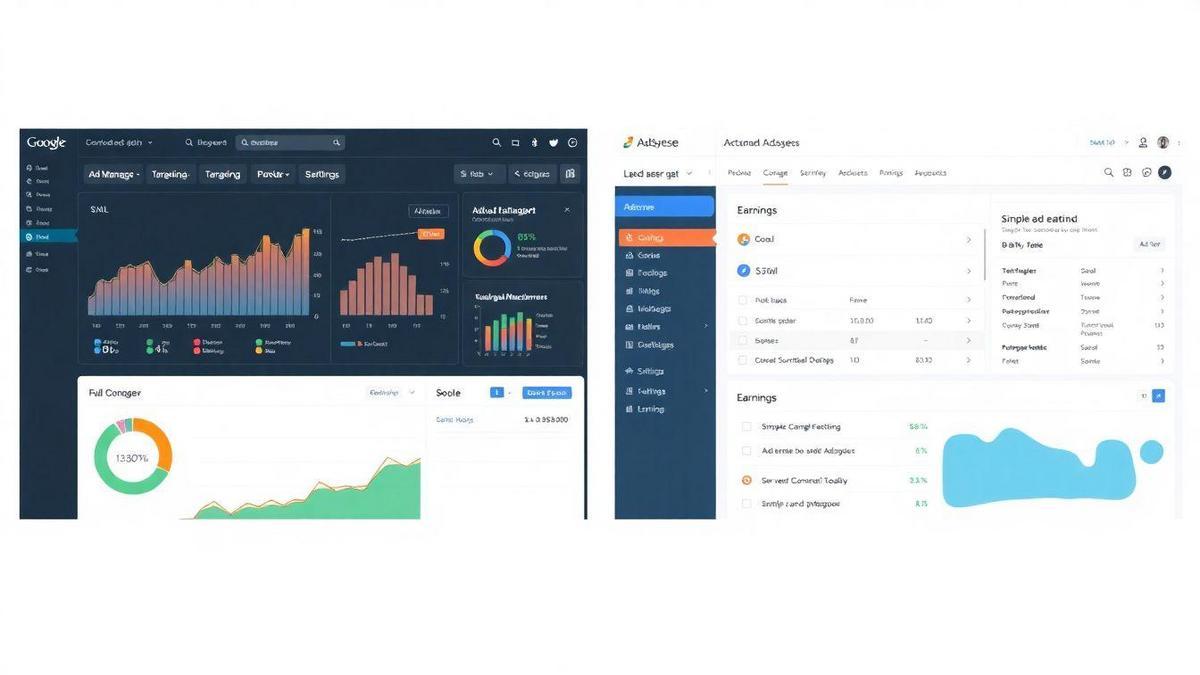Ad Manager vs. AdSense: Which to choose? If you’re stepping into the world of online ads, you might be feeling a bit overwhelmed. Don’t worry! This article is here to help you understand the basics of Google Ad Manager and AdSense. We’ll break down their key differences, how they can impact your ad revenue, and guide you on the right choice for your business. Get ready to dive in and make sense of your advertising journey!

Understanding the Basics of Ad Manager and AdSense
What is Google Ad Manager?
Google Ad Manager is a powerful tool that helps you manage your ads. If you’re running a website or app, you can use Ad Manager to sell ad space and track how well those ads are performing. Think of it as your personal ad control center. You can set up different campaigns, target specific audiences, and even control how much you earn from each ad.
What is Google AdSense?
On the other hand, Google AdSense is a bit simpler. It’s a way for you to earn money by displaying ads on your site. When someone clicks on these ads, you get paid. AdSense is great for those just starting out, as it’s easy to set up and doesn’t require much technical know-how. You simply sign up, add a few lines of code to your site, and watch the ads appear.
Key Differences Between Ad Manager and AdSense
| Feature | Google Ad Manager | Google AdSense |
|---|---|---|
| Target Audience | Advertisers and publishers | Website owners looking to earn |
| Control | High control over ad inventory | Limited control over ad types |
| Setup Complexity | More complex | Simple and quick |
| Earnings | Variable, based on deals | Pay-per-click or impressions |
In summary, if you’re looking for more control and have a larger audience, Google Ad Manager might be the way to go. But if you’re just starting and want something straightforward, Google AdSense is your best bet.
How Ad Manager vs. AdSense Impacts Your Ad Revenue
Maximizing Revenue with Ad Manager
When you think about boosting your ad revenue, Google Ad Manager can be a game-changer. This tool is like a Swiss Army knife for advertisers. It gives you control over your ad inventory, letting you manage multiple ad sources easily. You can set up direct deals with advertisers, which often leads to higher payouts.
With Ad Manager, you can also use advanced targeting. This means you can show the right ads to the right people. Think of it as having a personal shopper who knows exactly what you want. The more relevant the ads, the more likely users will click on them, and that means more money for you!
How AdSense Can Boost Your Earnings
On the flip side, AdSense is great for those just starting out. It’s user-friendly and doesn’t require much technical know-how. You simply place ads on your website, and Google takes care of the rest.
AdSense can also help fill gaps in your ad inventory. If you’re not selling all your ad space directly, AdSense can step in and fill those slots. This means you’re not leaving any money on the table.
Here’s a quick comparison of both platforms:
| Feature | Ad Manager | AdSense |
|---|---|---|
| Control | High | Low |
| Revenue Potential | High | Moderate |
| Setup Complexity | Moderate | Easy |
| Direct Deals | Yes | No |
| Fill Gaps | No | Yes |
Choosing the Right Platform for Your Needs
So, how do you decide between Ad Manager and AdSense? It really depends on your situation. If you have a lot of traffic and are ready to take charge, Ad Manager might be your best bet. It gives you the tools to maximize your revenue. However, if you’re just starting out or prefer a hands-off approach, AdSense is a solid choice.
Consider your audience, your goals, and how much time you want to invest. Each platform has its strengths, so pick the one that aligns with your needs.

The Role of Programmatic Advertising in Ad Manager
What is Programmatic Advertising?
Programmatic advertising is a way to buy and sell ads using technology. Instead of doing everything manually, it uses software to automate the process. This means you can reach your audience more quickly and efficiently. Think of it as a digital marketplace where ads are traded in real-time. You set your goals, and the system works to match your ads with the right people.
Benefits of Programmatic Ads in Ad Manager
When you use programmatic ads in Ad Manager, you open the door to several benefits:
- Targeting: You can reach specific audiences based on their behavior and interests.
- Cost-Effective: You often pay only for the ads that get results, which can save you money.
- Real-Time Data: You get instant feedback on how your ads are performing, allowing you to make quick adjustments.
- Scalability: You can easily scale your campaigns up or down based on your needs.
Here’s a quick comparison of the benefits:
| Benefit | Description |
|---|---|
| Targeting | Reach specific audiences |
| Cost-Effective | Pay for results only |
| Real-Time Data | Instant feedback for quick adjustments |
| Scalability | Easily adjust campaigns based on needs |
How Programmatic Advertising Increases Efficiency
Programmatic advertising boosts efficiency in several ways:
- Automation: With automation, you save time. You don’t have to worry about manual tasks.
- Better Decision Making: Real-time data helps you make smarter choices. You can see what works and what doesn’t.
- Less Wasted Spend: By targeting the right audience, you reduce wasted ad spend. This means more bang for your buck!
Imagine you’re throwing a party. Instead of inviting everyone in the neighborhood, you send invites only to those who love pizza and games. That’s what programmatic advertising does for your ads!
Performance Metrics: Measuring Success in Ad Manager and AdSense
Key Metrics to Track in Ad Manager
When you dive into Ad Manager, it’s all about keeping an eye on the right numbers. Here are the key metrics you should pay attention to:
- Impressions: This tells you how many times your ads are shown. More impressions can mean more chances for clicks!
- Clicks: This is the number of times someone clicks on your ad. Higher clicks usually mean your ad is doing its job.
- Click-Through Rate (CTR): This is a percentage that shows how many people clicked your ad compared to how many saw it. A higher CTR means your ad is attractive.
- Revenue: This is the cash you earn from your ads. Keeping track of revenue helps you see what’s working.
- Fill Rate: This shows how many of your ad requests were filled with an ad. A low fill rate might mean you need to adjust your strategy.
Important Metrics for AdSense Users
If you’re using AdSense, there are some specific metrics you should keep an eye on too:
- Page Views: This tells you how many times your pages are viewed. More views can lead to more ad clicks!
- Earnings Per Click (EPC): This shows how much money you earn each time someone clicks on your ad. Higher EPC means more earnings.
- Cost Per Click (CPC): This is the amount advertisers pay for each click. Knowing your CPC helps you understand your earnings.
- Ad Balance: This metric helps you see how many ads are shown versus how many are available. You want to find a good balance to maximize earnings.
Comparing Performance Metrics Between Both Platforms
Here’s a quick table comparing the key metrics between Ad Manager and AdSense:
| Metric | Ad Manager | AdSense |
|---|---|---|
| Impressions | Yes | Yes |
| Clicks | Yes | Yes |
| Click-Through Rate | Yes | Yes |
| Revenue | Yes | Yes |
| Fill Rate | Yes | No |
| Page Views | No | Yes |
| Earnings Per Click | No | Yes |
| Cost Per Click | No | Yes |
| Ad Balance | No | Yes |

Ad Management Tools: Features of Ad Manager and AdSense
Tools Available in Google Ad Manager
Google Ad Manager is a powerful tool that helps you manage your ads effectively. It offers a variety of features that can make your advertising efforts smoother. Here are some key tools you’ll find:
| Tool | Description |
|---|---|
| Ad Serving | Delivers ads to your site based on various criteria. |
| Reporting | Provides insights on ad performance, helping you make data-driven decisions. |
| Targeting Options | Allows you to reach specific audiences based on their interests and behaviors. |
| Inventory Management | Helps you keep track of your ad space and how it’s being used. |
With these tools, you can take control of your ad strategy and see what works best for your audience.
Features of Google AdSense You Should Know
Google AdSense is another great option for monetizing your content. It has features that can help you earn money while providing value to your visitors. Here’s what you should know:
| Feature | Description |
|---|---|
| Automatic Ads | Automatically places ads on your site, saving you time. |
| Ad Formats | Offers various formats like text, display, and video ads to fit your site’s design. |
| Performance Reports | Gives you detailed reports to track your earnings and ad performance. |
| Easy Integration | Simple to set up and integrate with your existing website. |
These features make AdSense a user-friendly choice for publishers looking to make some extra cash.
How These Tools Simplify Ad Management
Managing ads can be tricky, but both Google Ad Manager and AdSense make it easier for you. They save you time and help you focus on what really matters: your content.
Imagine you’re running a blog about cooking. With Ad Manager, you can serve ads that match your audience’s interests, like kitchen gadgets or recipe books. Meanwhile, AdSense can automatically place ads within your posts, so you don’t have to worry about where to put them. This means you can spend more time whipping up delicious recipes and less time stressing over ad placements.
Targeting Options: Ad Manager vs. AdSense
Audience Targeting in Ad Manager
When it comes to targeting your audience, Google Ad Manager gives you some powerful tools. You can really drill down into who sees your ads. Want to reach people based on their interests, location, or even their online behavior? You can do that!
Here are some key features of audience targeting in Ad Manager:
- Demographics: Target users by age, gender, and more.
- Interests: Reach people who have shown interest in topics that match your ads.
- Custom Segments: Create your own audience segments based on specific criteria.
Targeting Capabilities of AdSense
On the other hand, AdSense offers a simpler approach to targeting. While it may not be as detailed as Ad Manager, it still gets the job done. AdSense focuses on matching ads to the content on your site. This means that the ads you see are often related to what your visitors are reading or searching for.
Here’s a quick look at how AdSense targets ads:
| Feature | Ad Manager | AdSense |
|---|---|---|
| Customization | High – tailor ads to specific audiences | Low – based on content |
| Demographics | Yes | Limited |
| Interests | Yes | Limited |
| Control | Full control over ad placements | Minimal control |
How Targeting Affects Your Ad Performance
Now, let’s talk about how targeting impacts your ad performance. The more you know about your audience, the better your ads can perform. If you’re hitting the right people with the right message, you’ll likely see higher click-through rates and conversions.
For example, if you’re selling sports equipment, targeting sports enthusiasts will yield better results than a general audience.
In short, effective targeting can lead to better engagement and ultimately more revenue.

The Learning Curve: Getting Started with Ad Manager and AdSense
Is Ad Manager Hard to Use?
You might be wondering if Ad Manager is a tough nut to crack. The truth is, it can feel a bit overwhelming at first. But don’t let that scare you! With a little patience and practice, you’ll find that it’s all about getting used to the layout and features.
Many users say that once you get the hang of it, managing ads becomes a breeze. Think of it like learning to ride a bike. At first, you might wobble and fall, but soon enough, you’ll be cruising down the street with ease.
How Easy is it to Start with AdSense?
Now, let’s talk about AdSense. Starting with AdSense is generally smoother than Ad Manager. You can sign up, add a few lines of code to your website, and you’re off to the races! It’s like planting a seed and watching it grow.
Here’s a quick comparison to help you see the difference:
| Feature | Ad Manager | AdSense |
|---|---|---|
| Setup Time | Longer, requires some learning | Quick, easy setup |
| Control | More control over ads | Less control, automatic ads |
| Ideal For | Larger publishers | Smaller websites or blogs |
Tips for Beginners on Both Platforms
Whether you choose Ad Manager or AdSense, here are some handy tips to help you get started:
- Take Your Time: Don’t rush through the setup. Read through the guides and tutorials.
- Experiment: Try different ad formats and placements. See what works best for you.
- Stay Updated: Both platforms change often. Keep an eye on updates and new features.
- Ask for Help: Don’t hesitate to reach out to forums or support if you hit a snag.
Choosing Between Ad Manager and AdSense for Your Business
When to Use Ad Manager
If you have a large website or a network of sites, Ad Manager might be your best bet. It’s perfect for those who want to manage lots of ads at once. Here are some signs that Ad Manager is right for you:
- You have multiple ad spaces.
- You want to control who sees your ads.
- You need to track performance closely.
Ad Manager gives you the tools to manage all these aspects effectively. Imagine running a busy restaurant with many tables. You need a solid plan to manage all your customers and orders. Ad Manager helps you do just that for your ads!
When to Choose AdSense
On the flip side, if you’re just starting out or have a smaller website, AdSense might be a better fit. It’s easy to set up and requires less management. Here’s when to go with AdSense:
- You have a smaller audience.
- You want a simple setup.
- You prefer automatic ad placements.
Think of AdSense as a food truck. It’s quick, easy, and gets you started without much hassle. You can focus on what you love—creating content—while AdSense takes care of the ads.
Making the Right Choice for Your Advertising Strategy
Choosing between Ad Manager and AdSense boils down to your business needs. Here’s a quick comparison to help you decide:
| Feature | Ad Manager | AdSense |
|---|---|---|
| Best for | Large websites | Smaller websites |
| Control over ads | High | Low |
| Complexity of setup | High | Low |
| Revenue potential | High | Moderate |
In the end, think about what you want from your advertising. If you’re looking for control and have a larger operation, Ad Manager is your friend. If you want a simple way to start earning from your site, AdSense is the way to go.

Future Trends in Digital Advertising: Ad Manager and AdSense
Upcoming Changes in Ad Manager
As you dive into the world of digital advertising, you might wonder what’s coming next in Ad Manager. Well, hold onto your hats! There are some exciting changes on the horizon.
One big shift is the integration of AI tools. These tools will help you analyze your ad performance better and make smarter decisions. Imagine having a personal assistant that crunches numbers and gives you insights in real time. This means you can tweak your ads on the fly and reach your audience more effectively.
Here’s a quick look at what to expect:
| Change | Description |
|---|---|
| AI Integration | Enhanced analytics and real-time adjustments |
| Improved UX | A more user-friendly interface for easier navigation |
| Enhanced Reporting | Better data visualization for clearer insights |
What’s Next for AdSense Users?
If you’re using AdSense, there are some updates aimed at making your experience smoother. Google is focusing on increased transparency. This means you’ll get clearer information about how your ads are performing and how much you’re earning.
You can also expect new ad formats that are more engaging. Think about how video ads can grab attention more than static ones. With these changes, you’ll likely see better results and higher earnings.
Preparing for the Future of Online Ads
So, how can you get ready for these changes? Here are some tips to keep you ahead of the game:
- Stay Informed: Keep an eye on updates from Google. They often share valuable information about new features.
- Experiment: Don’t be afraid to try out new ad formats or strategies. Testing is key to finding what works best for you.
- Engage with Your Audience: Always think about your audience. Create ads that speak to them directly.
By being proactive, you can take full advantage of what’s coming next in Ad Manager and AdSense.
Frequently asked questions
What is the main difference between Ad Manager and AdSense?
Ad Manager is for publishers who want more control. AdSense is simpler. Choose Ad Manager for advanced options.
Which platform earns more money?
It depends on your setup. Ad Manager can make more with better ad placements. AdSense is easier but might earn less.
Can I use Ad Manager and AdSense together?
Yes, you can! Some use both for more ad options. Just remember to manage them well.
Who should use Ad Manager?
If you have a big site and want to optimize ads, go for Ad Manager. It’s perfect for experienced users.
Is AdSense better for beginners?
Absolutely! AdSense is great for newbies. It’s user-friendly and easy to start with. Perfect for your first step!

Marina is a passionate web designer who loves creating fluid and beautiful digital experiences. She works with WordPress, Elementor, and Webflow to create fast, functional, and visually stunning websites. At ReviewWebmaster.com, she writes about tools, design trends, and practical tutorials for creators of all levels.
Types of articles she writes:
“WordPress vs. Webflow: Which is Best for Your Project?”
“How to Create a Visually Stunning Website Without Hope”
“Top Landing Page Design Trends for 2025”
Why it works:
She brings a creative, accessible, and beginner-friendly perspective to the blog, perfectly complementing Lucas’s more technical and data-driven approach.
